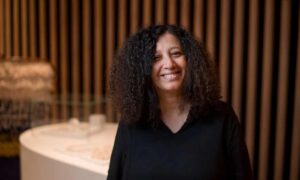
The idea of weaving an artwork from palm husks came to Amina Agueznay during a workshop she was leading in Morocco’s Souss-Massa region, as part of a project with local rug weavers to renovate Tissekmoudine, a ksar, or fortified village.
“The plan was to integrate the palm trees from the oasis in our designs, so I encouraged the women to look around them and use whatever material they could find,” says Agueznay, who this month won the Norval Sovereign African art prize, worth $35,000 (£28,000).
“We decided to weave with what, in the Berber language, the women call talefdamt [palm husk],” Agueznay recalls. “We deconstructed it to create a thread that we could use.”
The winning work, Portal #1, is reminiscent of a jagged-edge motif found on Moroccan rugs and inspired by the symbols painted on the doors of a ksar.
The architect turned artist, who is known for collaborating with rural craftworkers and documenting their designs and traditions, says she feels “blessed” by the win.
“This prize is an encouragement and the will to continue, empowering women that I work with. I lead workshops throughout Morocco and what happens is that I always go back. There is a continuity, and continuity is very important to me – what we call la pérennité [sustainability].
Born in 1963, she is the daughter of Malika Agueznay, who is among Morocco’s first female modernist abstract artists and a member of the celebrated Casablanca Art School.
Moving to the US for 15 years after school, Agueznay studied architecture in Washington and practised there and in New York before returning to Morocco in 1997. She started working on smaller-scale projects, such as jewellery, before expanding to large art installations.
“I returned to Morocco to explore scale in a meaningful way,” Agueznay says. “I can’t hug my buildings, but I can hug my artwork.”
